Overview
We recognize that transitioning to cloud-based systems is a complex endeavor for medical institutions, yet it is crucial for enhancing operational efficiency and ensuring compliance with regulatory standards. Our article outlines nine essential strategies for successful healthcare cloud migration, including:
- Conducting comprehensive risk assessments
- Developing tailored migration plans
- Engaging specialized providers
- Implementing strong security measures
- Fostering team collaboration
Each of these strategies is designed to address specific challenges and streamline the migration process. What’s holding your team back from embracing this transformative shift? By adopting these best practices, we can navigate the intricacies of cloud migration together, ensuring a smooth transition that meets both operational and regulatory demands.
Introduction
In the rapidly evolving landscape of healthcare, we recognize that the migration to cloud-based solutions presents both opportunities and challenges. As organizations strive to enhance operational efficiency and patient care, we understand that the complexities of securely transitioning from legacy systems to the cloud can seem daunting.
This article delves into the essential strategies for successful healthcare cloud migration, highlighting the pivotal role of Avato’s hybrid integration platform in ensuring seamless transitions. From conducting comprehensive risk assessments to fostering team collaboration and embracing innovation post-migration, we equip healthcare providers with the tools needed to navigate this transformative journey while safeguarding sensitive data and maintaining compliance with stringent regulations.
Avato: Streamline Healthcare Cloud Migration with a Secure Hybrid Integration Platform
At Avato, we recognize the complexities involved in healthcare cloud migration of medical systems. Our hybrid integration platform is meticulously designed to simplify this process. By securely connecting isolated legacy systems and fragmented data, we enable medical institutions to transition seamlessly while adhering to stringent regulatory requirements, including security frameworks such as NIST, CIS, and CSA.
What if we told you that our platform’s advanced features, including real-time monitoring and alerts, ensure that critical integrations function continuously? This capability significantly reduces downtime during transitions, which is essential for medical service providers seeking uninterrupted access to patient information and services. In fact, entities utilizing our cloud-based services have reported a remarkable 43% decrease in security incidents, underscoring how our features enhance security during migration.
Moreover, our platform greatly lowers expenses related to integration, making it a financially prudent choice for medical organizations. As medical computing evolves, enhancing operational flexibility—especially in emergencies—becomes crucial. This agility allows for swift modifications in service provision. As we anticipate additional workloads transitioning to online services, our commitment to streamlining intricate projects has garnered recognition from industry leaders. Their endorsements highlight our efficiency in achieving outcomes within targeted timelines and financial constraints.
In this rapidly changing realm of medical data transition, where security and efficiency are paramount, we position ourselves as a vital partner. Let us help you navigate the complexities of healthcare cloud migration with confidence and expertise.
Conduct a Comprehensive Risk Assessment to Identify Vulnerabilities
Before we initiate a shift to virtual services, it is imperative that we conduct a thorough risk evaluation. This essential process involves identifying potential vulnerabilities within our current systems, assessing compliance with medical regulations, and understanding the ramifications of data breaches. Recent data underscores that for every dollar we invest in email security, we can prevent an average of $14 in breach-related costs. This highlights the financial implications of inadequate security protocols, particularly concerning the risks tied to the transition to digital services.
A comprehensive risk assessment must encompass evaluations of data protection, operational continuity, and regulatory compliance. For instance, the Federal Trade Commission’s enforcement of the Health Breach Notification Rule in 2023 has resulted in substantial penalties for non-compliance, illustrating the urgent necessity for vigilance in safeguarding personal health information. By actively evaluating risks, we can devise effective strategies to mitigate them, thereby protecting patient information and enhancing stakeholder trust throughout the transition process. Furthermore, recognizing weaknesses in our medical systems prior to the shift is crucial. Cybersecurity experts advise us to conduct thorough assessments of network workstations, servers, and remote access points, as these elements are critical to our cybersecurity posture in U.S. medical facilities. Recent data confirms that these areas are vital for comprehensive risk assessments.
By implementing best practices for risk evaluation—such as conducting regular security audits and involving cybersecurity specialists—we can navigate the complexities of online transitions while ensuring robust protection against potential threats. Additionally, integrating continuous monitoring and analytics capabilities into our hybrid integration solutions can yield valuable insights that optimize operations and bolster compliance efforts. These analytics capabilities encompass real-time performance tracking, anomaly detection, and automated reporting, all essential for maintaining compliance and enhancing overall system performance. This proactive approach not only mitigates risks but also aligns with the compliance obligations highlighted by Steve Alder, editor-in-chief of The HIPAA Journal, who notes that while covered entities and business associates share many HIPAA compliance obligations, the application of these regulations can differ significantly based on organizational activities.
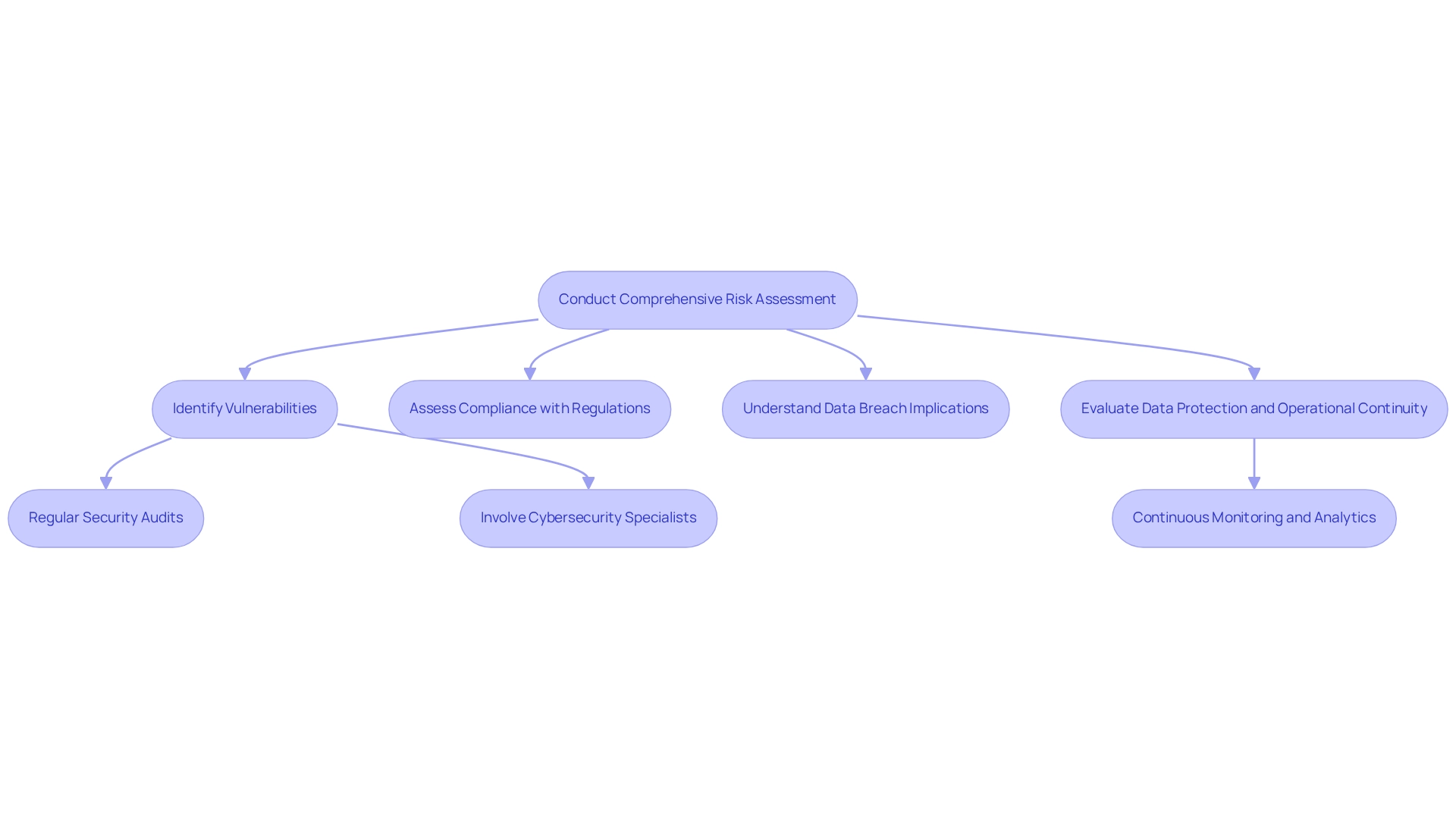
Develop a Tailored Cloud Migration Strategy for Healthcare Organizations
Developing a customized plan for healthcare cloud migration is essential for healthcare entities navigating the complexities of digital transformation. We must consider various factors, including the specific applications we are migrating, the regulatory landscape, and our long-term objectives. A successful migration strategy encompasses several critical components:
- Defining Clear Objectives: Establishing measurable goals ensures that our migration aligns with the organization’s vision and operational needs.
- Selecting Appropriate Cloud Service Models: Choosing between Infrastructure as a Service (IaaS), Platform as a Service (PaaS), and Software as a Service (SaaS) is vital for optimizing resource allocation and functionality.
- Implementing a Phased Migration Strategy: Gradually moving to the online environment allows us to manage risks effectively and minimize disruptions to ongoing operations. Avato’s hybrid integration platform plays a crucial role in this phased approach, empowering us to future-proof our operations through seamless data and system integration.
By customizing our healthcare cloud migration plan, we can harness cloud technologies to enhance efficiency and service delivery while ensuring compliance with industry regulations. This includes ensuring adherence to regulatory compliance and performing security audits, which are essential for protecting sensitive medical data. Reliability throughout this process is underscored by our commitment to guaranteeing 24/7 uptime for essential integrations, which is vital for continuous medical services. Furthermore, investing in thorough employee training and change management tactics is crucial to ensure that our IT experts are prepared to tackle the unique challenges that arise during system transitions. As the medical field continues to evolve, a well-planned transition strategy, supported by our dedication to streamlining diverse systems, will enable us to thrive in an increasingly digital environment.
Engage Specialized Providers for Expert Cloud Migration Support
Involving specialized service providers for online transitions significantly enhances the success of our medical entities’ shifts to digital platforms. These experts possess a deep understanding of the complexities inherent in cloud environments, ensuring we adhere to essential regulations such as HIPAA and GDPR. By leveraging their knowledge, we can navigate potential obstacles and expedite our transition schedules. Specialized providers, such as Avato, deliver tailored solutions that address the unique requirements of medical organizations, streamlining the transition process and enhancing overall efficiency.
Statistics reveal that transitioning medical data not only boosts our operational efficiency but also enhances patient safety by providing comprehensive visibility into prescribed medications and administered tests. With the medical computing market projected to expand at a CAGR of 17.6% from 2025 to 2032, the role of specialized providers becomes increasingly vital. Their ability to implement best practices for data security and compliance ensures that we can protect sensitive information during the transfer process, ultimately leading to successful outcomes.
As noted by Gustavo Estrada, a customer of Avato, “Avato has the ability to simplify complex projects and deliver results within desired time frames and budget constraints.” This statement underscores the importance of partnering with specialized providers who can effectively manage the complexities of data transfer.
Furthermore, we must address regulatory and compliance challenges during data transition, as highlighted in case studies that emphasize the necessity for service providers to meet compliance standards and safeguard information. To maximize the benefits of our digital transition, we should consider forming alliances with expert suppliers like Avato, who can support us throughout the process and ensure adherence to regulations.
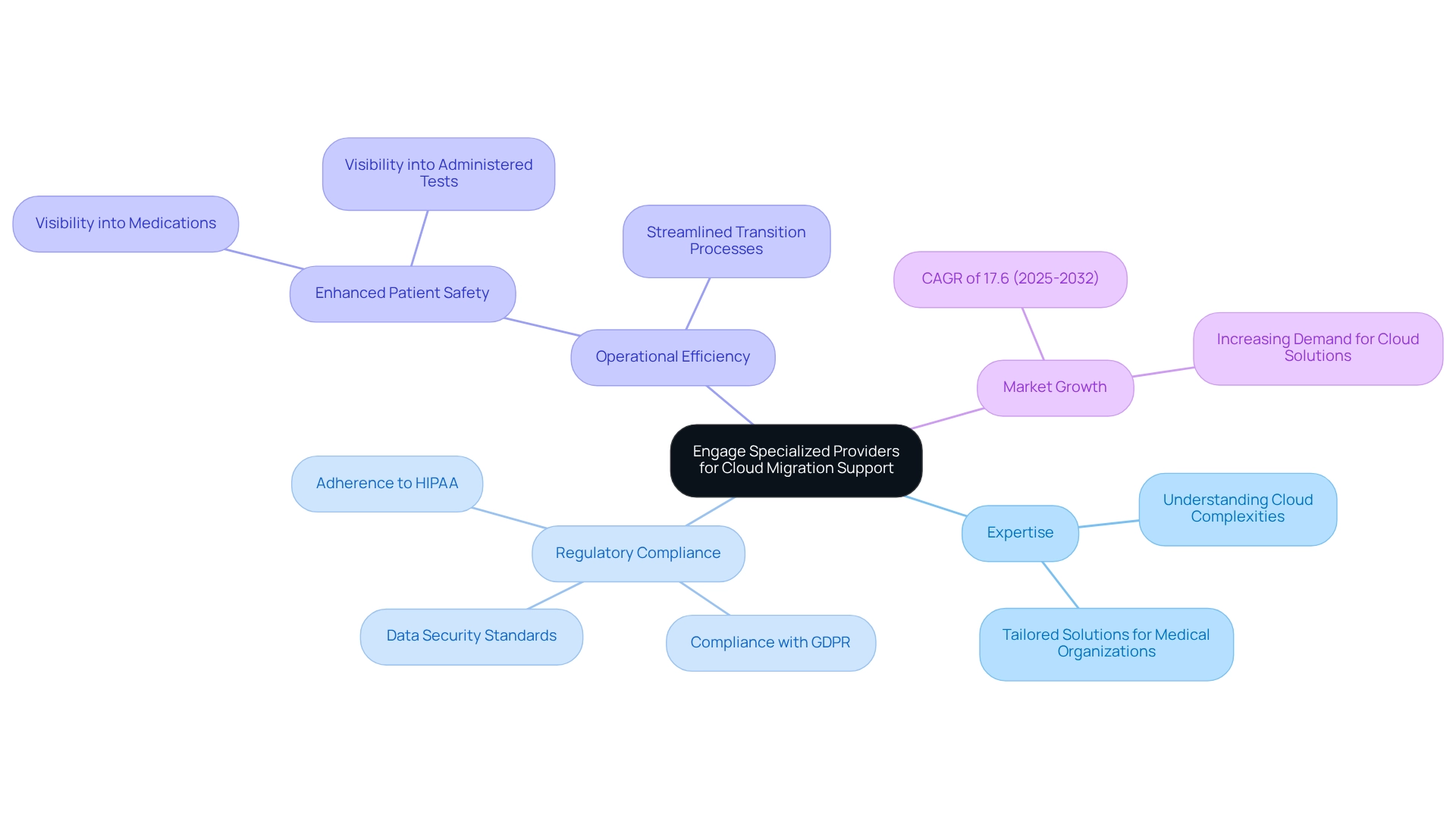
Implement Strong Access Controls and Encryption for Data Protection
To effectively safeguard sensitive medical information during and after data migration, we must prioritize the establishment of strong access controls and encryption protocols. Access controls should be designed with role-based permissions, ensuring that only authorized personnel can access specific data sets. This approach not only minimizes the risk of unauthorized access but also aligns with compliance requirements such as HIPAA.
Encryption plays a pivotal role in data security, necessitating that data is encrypted both at rest and in transit. This dual-layered encryption strategy is essential for preventing unauthorized access and mitigating the risk of data breaches. Consider this: out of 543 network server breaches, 348 were reported in the last four years, with 22.03% occurring in 2019. This statistic highlights the prevalence of data breaches stemming from weak access controls, underscoring the need for stringent security measures.
As cybersecurity expert A.H.S. noted, “Implementing strong access controls and encryption is not just a best practice; it is a necessity in today’s digital landscape to protect sensitive information from evolving threats.”
Implementing these best practices not only protects patient information but also improves the overall security stance of medical organizations. Effective data protection strategies during digital transitions demonstrate that proactive measures, including robust access controls and thorough encryption, are essential in preserving the integrity and confidentiality of sensitive medical data. Moreover, a case study titled ‘Forecasting Data Breaches in Healthcare’ indicates a consistent increase in both the number of data breaches and the costs associated with compromised medical records, suggesting that proactive measures are necessary to mitigate future risks.
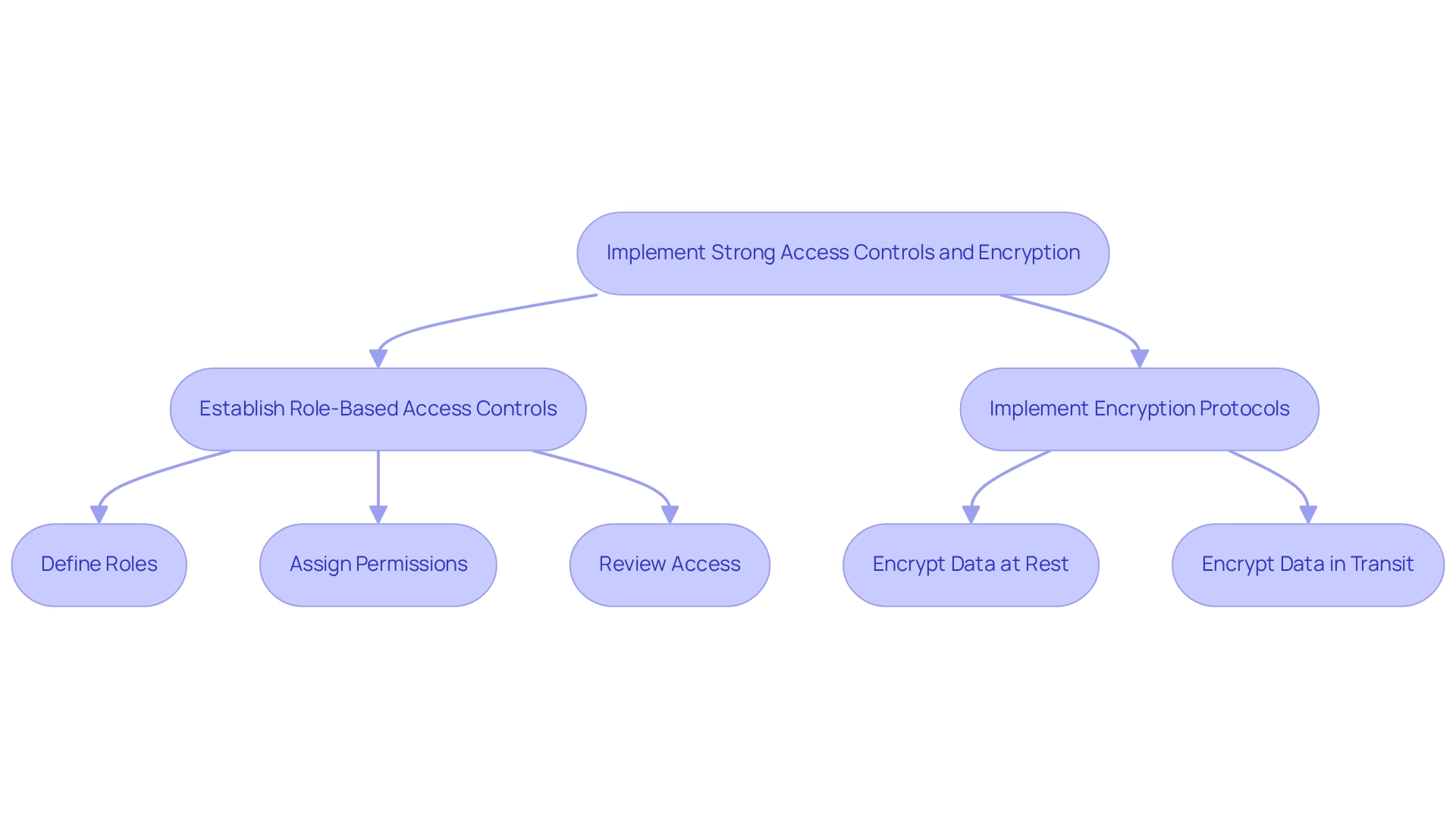
Regularly Update and Test Security Measures to Ensure Data Integrity
We must recognize that healthcare entities face a pressing challenge: the necessity of prioritizing the regular updating and testing of security measures to safeguard the integrity of data stored in the cloud. This is not merely about applying security patches and updating encryption protocols; it also involves conducting thorough vulnerability assessments.
Regular testing practices, including penetration testing and security audits, are essential for identifying potential weaknesses before they can be exploited. Given that medical data breaches cost an average of $408 per record—significantly higher than the cross-industry average—proactive security measures become crucial. This statistic underscores the challenges we encounter in sustaining strong security amid rising threats.
Furthermore, with just 47% of medical facilities indicating that their ransom payments were covered by cybersecurity insurance, the consequences of this gap in coverage are considerable, especially as we navigate digital transformation and security risks. By adopting a proactive approach to security, we can better safeguard sensitive patient information and ensure compliance with evolving regulations, ultimately enhancing our resilience against cyber threats.
As Megan Garza, Communications Manager for Varonis, emphasizes, “Regular updates are essential to stay ahead of potential vulnerabilities.” To implement these practices effectively, we should establish a routine schedule for security updates and testing, ensuring that our defenses evolve alongside emerging threats.
Train Staff on Security Best Practices for Cloud Environments
Training our personnel on security best practices is crucial as we transition medical institutions to the cloud, particularly when utilizing Avato’s hybrid integration platform. We must equip our employees to recognize phishing attempts, manage passwords securely, and understand the significance of data protection. Effective cybersecurity awareness training provides individuals with essential threat prevention tools, benefiting not just the organization but also each team member. To facilitate this, we recommend the following actionable steps:
- We should invest in comprehensive training programs to ensure our staff is comfortable with Avato’s platform.
- Implementing regular training sessions and workshops focused on security awareness is vital.
- Conducting simulated phishing exercises will bolster our staff’s readiness.
A culture of security awareness empowers our employees and leads to a remarkable 70% reduction in security incidents, underscoring the importance of proactive education. Furthermore, with 75% of businesses having incurred financial losses due to voice scams, prioritizing these initiatives is essential. By doing so, we can effectively mitigate the risk of human error, a leading cause of data breaches during healthcare cloud migration.
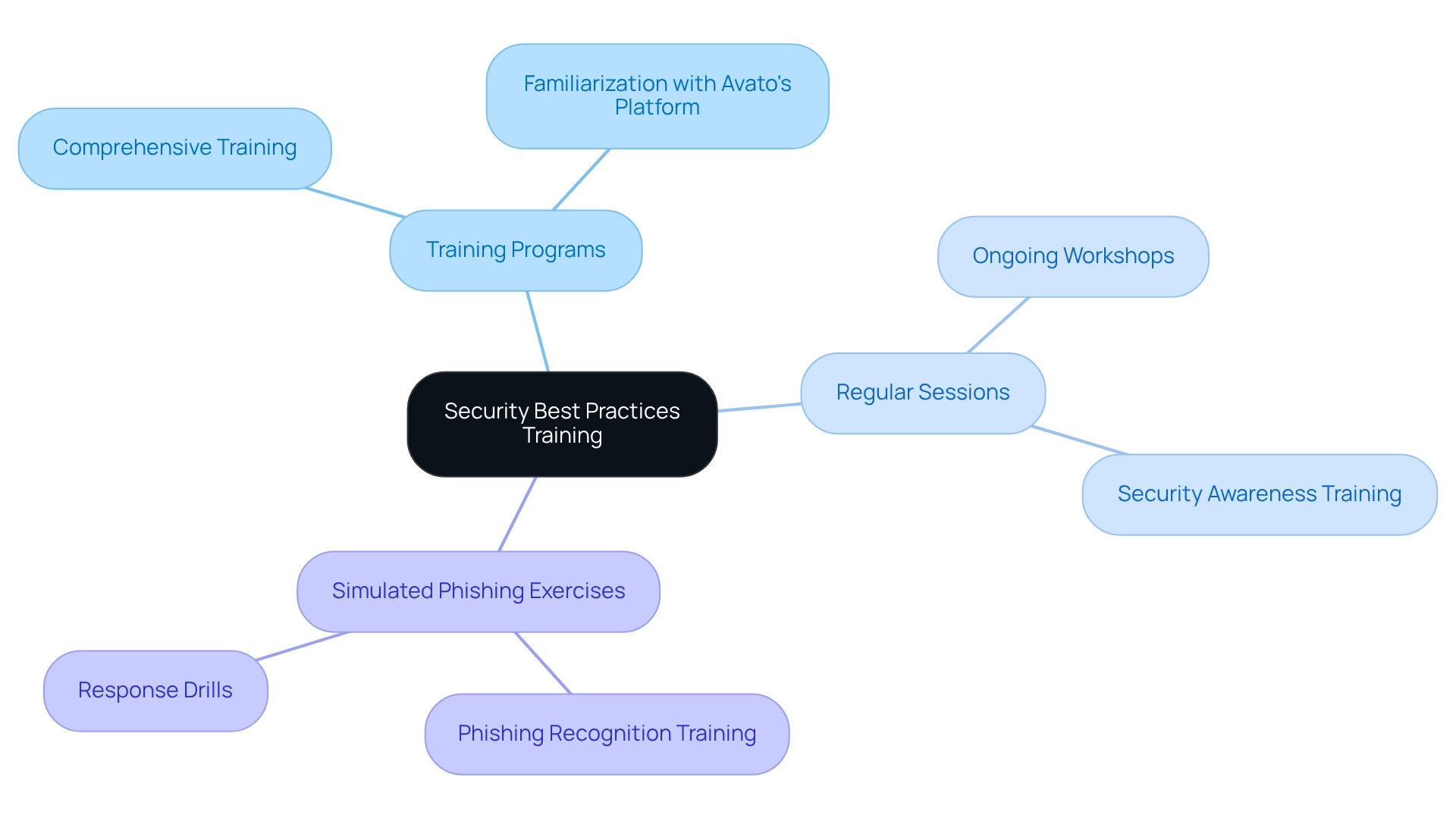
Establish a Clear Communication Plan for Stakeholder Engagement
A clearly outlined communication strategy is essential for effectively involving stakeholders during the cloud transition process, particularly in the context of preparing for open banking. We must specify how information will be disseminated, the frequency of updates, and the communication channels utilized. Frequent updates to stakeholders—including leadership, IT teams, and end-users—are crucial for maintaining alignment and transparency about the project’s progress.
By promoting a culture of transparent communication, we can promptly tackle issues, thereby maintaining backing for the transition effort. Notably, only 40% of employees feel their employers excel at enhancing workplace wellbeing, which underscores the need for improved communication strategies, particularly in the banking sector where regulatory and operational complexities abound.
As we manage shifts to digital platforms, emphasizing stakeholder involvement through organized communication strategies can greatly improve the overall success of the healthcare cloud migration. This is particularly important as the success of open banking depends heavily on establishing secure and reliable connections between applications, necessitating clear communication about compliance and security protocols.
To mobilize stakeholders effectively, we should utilize the right technology and tools to illustrate current and ideal states, ensuring that everyone is on the same page. As Gustavo Estrada, a customer, noted, ‘Avato has simplified complex projects and delivered results within desired time frames and budget constraints.’ This highlights the effectiveness of clear communication in achieving successful outcomes.
Moreover, incorporating flexibility and mental health support into our communication strategies can better align with the needs of stakeholders during transitions to the digital environment. Furthermore, utilizing current systems while maintaining adherence to security protocols is vital for a seamless transition process.
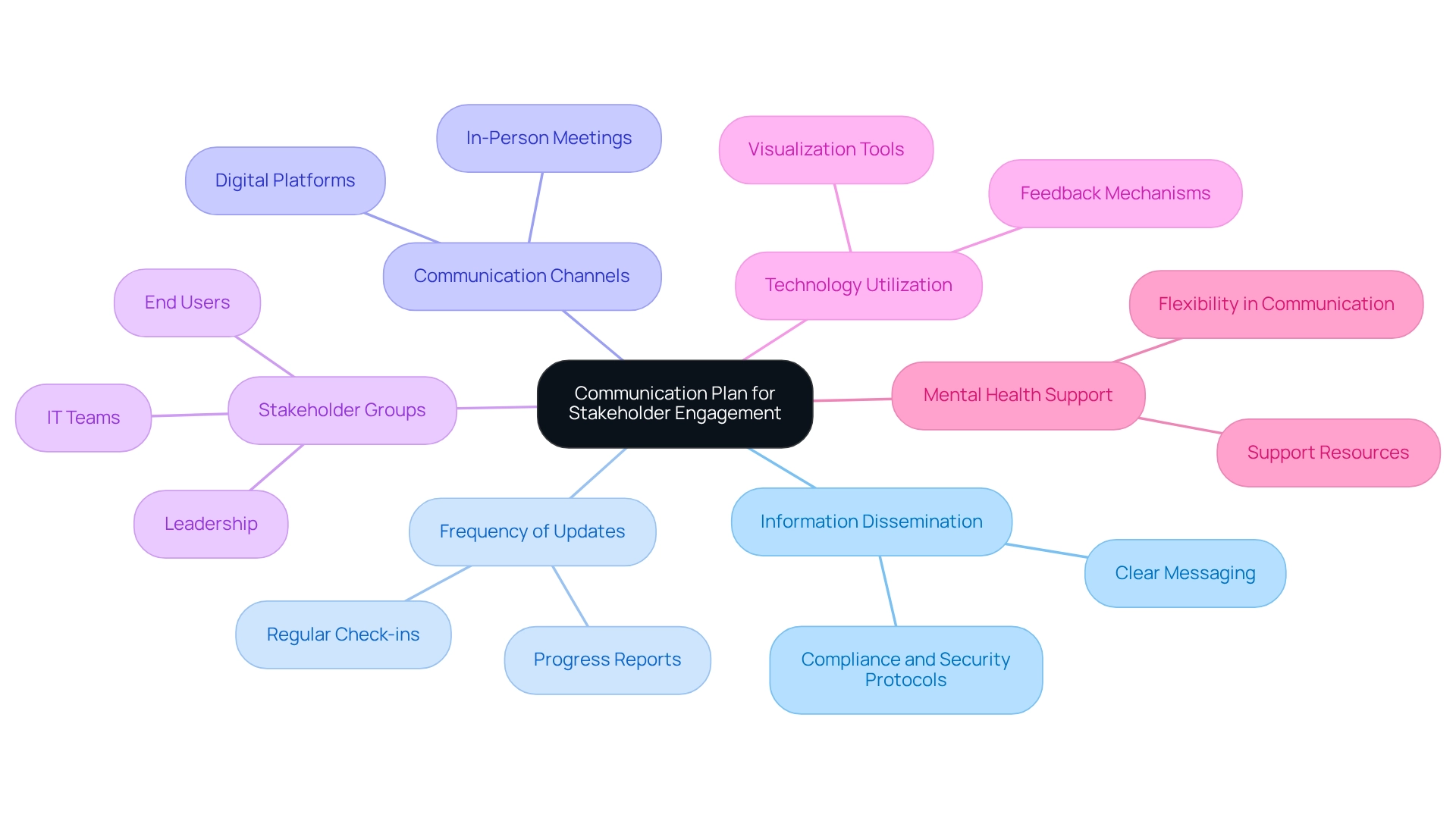
Foster Team Collaboration to Enhance Migration Efficiency
Encouraging team collaboration is crucial for enhancing efficiency during healthcare cloud migration. What’s holding your team back from achieving optimal performance? Promoting collaboration among cross-functional teams enables the exchange of insights and joint problem-solving, which is essential in managing the challenges of transition.
Utilizing collaboration tools, such as project management software and communication platforms, facilitates real-time interaction and information exchange, significantly enhancing team dynamics. Research indicates that smaller teams can be more efficient; for instance, a study revealed that four-person teams took 44% longer to complete tasks compared to two-person teams. This highlights the potential for streamlined processes when teams are appropriately sized and focused.
Furthermore, 21% of employees recognize that workplace collaboration and engagement directly contribute to higher profitability, underscoring the financial benefits of effective teamwork. As we foster a collaborative atmosphere, we can utilize varied expertise and viewpoints, resulting in more efficient problem-solving and a smoother transition process.
Present trends indicate a growing dependence on collaborative technologies in healthcare IT initiatives; that’s why it’s essential for teams to embrace these tools to improve their effectiveness during healthcare cloud migration. Additionally, guaranteeing dependable systems is essential; Avato’s devoted hybrid integration platform illustrates the operational effectiveness that we should aim for during the transition, with a commitment to 24/7 uptime for vital integrations.
By examining the practices of high-performing teams, we can further enhance our collaborative efforts, addressing the challenges posed by remote work, where 40% of remote workers miss spontaneous, in-person connections with teammates.
Embrace Innovation After Migration to Maximize Cloud Benefits
Post-cloud migration, we must prioritize innovation to fully leverage our new capabilities. This involves integrating advanced technologies such as artificial intelligence (AI), machine learning, and data analytics, which can significantly enhance patient care and operational efficiency. A recent survey indicated that 24% of medical facilities plan to shift to online contact centers within the next two years, highlighting a growing trend towards optimizing patient interactions through online solutions. Moreover, it is significant that merely 24 public internet services were employed by the medical sector in 2023, underscoring the necessity for innovation to enhance our online capabilities.
By consistently optimizing internet resources and adopting cutting-edge technologies, we can enhance patient outcomes and simplify operational processes. The successful transition of medical entities that have collaborated with Avato to utilize its hybrid integration platform serves as a compelling case study. This transition allows us to attain the scalability required to satisfy growing demand, guaranteeing a dependable experience for users. Additionally, cooperation between health IT experts and clinicians is crucial for promoting AI integration. As highlighted in recent discussions with Resa Lewiss, MD, optimizing workflows in emergency medicine can lead to enhanced patient care and operational efficiency. The integration of Avato’s hybrid integration platform is foundational for these advancements. It allows for seamless data sharing and automation, ultimately fostering rich, connected customer experiences.
Avato’s hybrid integration platform empowers us in five strategic ways:
- Enhancing data accessibility
- Improving operational efficiency
- Enabling real-time insights
- Facilitating secure data sharing
- Supporting the integration of emerging technologies
By adopting these innovations, we can not only adjust to the changing environment but also preserve a competitive advantage in providing high-quality care. This focus on collaboration and innovation aligns with actionable strategies for successful healthcare cloud migration, ensuring that we are well-prepared to harness the full potential of our cloud investments.
Conclusion
The successful migration to cloud-based solutions in healthcare is not just a technical necessity; it is a strategic opportunity that hinges on critical strategies ensuring both security and efficiency. We recognize that Avato’s hybrid integration platform is a vital tool in this process, enabling healthcare organizations to link legacy systems and fragmented data seamlessly. By prioritizing comprehensive risk assessments, developing tailored migration strategies, and engaging specialized providers, we can navigate the complexities of cloud transitions while maintaining compliance with stringent regulations.
Furthermore, implementing strong access controls and encryption, alongside regular updates and testing of security measures, is essential for safeguarding sensitive patient data. What’s holding your team back from cultivating a culture of awareness? The importance of staff training on security best practices cannot be overstated, as it significantly reduces security incidents. Effective communication and fostering team collaboration further enhance the migration process, ensuring that all stakeholders remain aligned and engaged throughout the transition.
Post-migration, our focus must shift towards embracing innovation to maximize the benefits of cloud technologies. By integrating advanced technologies such as AI and data analytics, we can enhance patient care and operational efficiency, ultimately leading to improved outcomes. Avato’s commitment to empowering organizations through our hybrid integration platform positions us to thrive in an increasingly digital landscape.
In summary, the journey to cloud migration is not merely a technical transition but a strategic opportunity for healthcare organizations to innovate and improve service delivery. By leveraging the right tools and strategies, we can ensure a secure, efficient, and effective migration that lays the groundwork for future advancements in patient care.

